Advertisement.
EnchantedLearning.com is a user-supported site.
As a bonus, site members have access to a banner-ad-free version of the site, with print-friendly pages.
Click here to learn more.
(Already a member? Click here.)
SEISMOSAURUS
Seismosaurus information/coloring printout
Simple Seismosaurus Printout
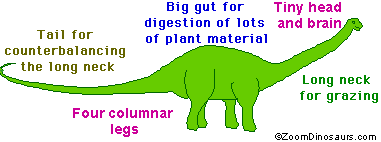 |
SEISMOSAURUS
"Quake Lizard"
- A long-neck, whip tailed plant eater
- Small head with spatulate or pencil-shaped teeth
- Walked on four short, thick legs
- Among the longest land animals ever!
|
ANATOMY
Seismosaurus was an enormous, long-necked, whip-tailed, small-headed dinosaur. It measured about 130-170 feet (39-52 m) long and was roughly 18 feet (5.5 m) tall (measured from the ground to the top of the shoulder). may have weighed about 30 tons (roughly 60,000 pounds). It was among the longest land animals that ever lived.
Seismosaurus' nostrils were at the top of its tiny head. Its small mouth had peg-like teeth, but only in the front of the jaws. Its front legs were shorter than its back legs, and all had elephant-like, five-toed feet. Its short legs may have helped stabilize this enormous dinosaur. One toe on each foot had a thumb claw, probably for protection. Its backbone had extra bones underneath it, which had bony protrusions running both forwards and backwards (chevron shaped), probably for support and extra mobility of its neck and tail. Seismosaurus' tail contained at least one unusual wedge-shaped vertebra that gave it a kink. It may have used this whip-like tail for protection.
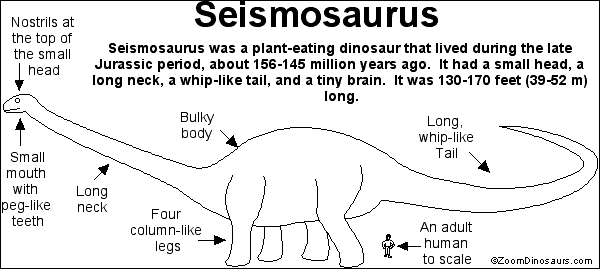
WHY WAS SEISMOSAURUS' NECK SO LONG?
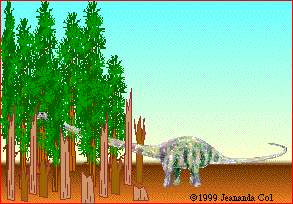 Seismosaurus held its neck more-or-less horizontally (parallel to the ground). The long neck may have been used to poke into forests to get foliage that was otherwise unavailable to the huge, lumbering varieties of sauropods who could not venture into forests because of their size. Alternatively, the long neck may have enabled this sauropod to eat soft pteridophytes (horsetails, club mosses, and ferns). These soft-leaved plants live in wet areas, where sauropods couldn't venture, but perhaps the sauropod could stand on firm ground and browse in wetlands.
Seismosaurus held its neck more-or-less horizontally (parallel to the ground). The long neck may have been used to poke into forests to get foliage that was otherwise unavailable to the huge, lumbering varieties of sauropods who could not venture into forests because of their size. Alternatively, the long neck may have enabled this sauropod to eat soft pteridophytes (horsetails, club mosses, and ferns). These soft-leaved plants live in wet areas, where sauropods couldn't venture, but perhaps the sauropod could stand on firm ground and browse in wetlands.
DIET
Seismosaurus was an herbivore (it ate only plants). Seismosaurus had blunt, peg-like teeth, useful for stripping foliage. It must have eaten a tremendous amount of plant material each day to sustain itself. It probably swallowed leaves whole, without chewing them, and had gastroliths (stomach stones) in its stomach to help digest this tough plant material. Many of these fossilized gastroliths have been found in the middle of the Seismosaurus skeleton.
Its main food was probably conifers, which were the dominant plant when the large sauropods lived. Secondary food sources may have included gingkos, seed ferns, cycads, bennettitaleans, ferns, club mosses, and horsetails.
BEHAVIOR
Herds: Seismosaurus may have travelled in herds and may have migrated when they deleted their local food supply.
Eggs: They may have hatched from eggs, like other sauropods. Sauropod eggs have been found in a linear pattern and not in nests; presumably the eggs were laid as the animal was walking. It is thought that sauropods did not take care of their eggs.
Life span: Sauropods life spans may have been in the order of 100 years.
Protection: It may have used its whip-like tail for protection.
INTELLIGENCE
It used to be thought that the sauropods (like Seismosaurus, Diplodocus, Brachiosaurus and Apatosaurus) and some other dinosaurs had a second brain. Paleontologists now think that what they thought was a second brain was just an enlargement in the spinal cord in the hip area. This enlargement was larger than the animal's tiny brain.
Seismosaurus was a sauropod, whose intelligence (as measured by its relative brain to body weight, or EQ) was the among the lowest of the dinosaurs.
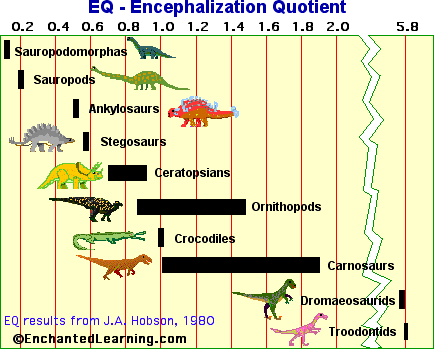
LOCOMOTION
Seismosaurus moved slowly on four short, column-like legs (as determined from fossilized tracks and its leg length and estimated mass). Its short legs may have helped stabilize the enormous, low-slung Seismosaurus.
WHEN SEISMOSAURUS LIVED
Seismosaurus lived during the late Jurassic Period, from 156-145 million years ago. The late Jurassic was the time of many enormous sauropods, including Camarasaurus, Apatosaurus, and Brachiosaurus. Also present were Stegosaurus, Tuojiangosaurus, Allosaurus, Supersaurus, Coelurosaur, and many others.
FOSSILS
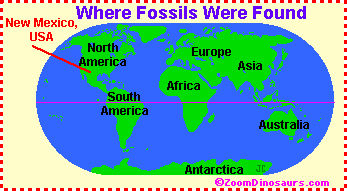 Seismosaurus was named by paleontologist Gillette in 1991. Seismosaurus fossils have been found in New Mexico, USA. The incomplete fossil includes many gastroliths (gizzard stones), vertebrae (parts of the backbone), chevrons from the spine, some ribs, partial pelvis (hip), and some other assorted bones.
Seismosaurus was named by paleontologist Gillette in 1991. Seismosaurus fossils have been found in New Mexico, USA. The incomplete fossil includes many gastroliths (gizzard stones), vertebrae (parts of the backbone), chevrons from the spine, some ribs, partial pelvis (hip), and some other assorted bones.
CLASSIFICATION
Seismosaurus was a huge herbivorous dinosaur, a saurischian ("lizard hipped" dinosaurs), a sauropodomorph (A long-necked, long-tailed plant-eater that walked on four legs), a sauropod (a very large herbivore), and a member of the Family Diplodocidae (a peg-toothed sauropod: others included Apatosaurus, Amargasaurus, Diplodocus, and Supersaurus).
The type species is S. hallorum.
Some paleontologists think that Seismosaurus may be a very large example of the genus Diplodocus and not a separate genus.
PRINTOUTS
Seismosaurus information/coloring printout
Seismosaurus printout (Simple versions)
 Information Sheets About Dinosaurs Information Sheets About Dinosaurs
(and Other Prehistoric Creatures) |
Just click on an animal's name to go to that information sheet. If the dinosaur you're interested in isn't here, check the Dinosaur Dictionary or the list of Dinosaur Genera. Names with an asterisk (*) were not dinosaurs.
How to write a great dinosaur report.
For dinosaur printouts, click here.For brief dinosaur fact sheets, click here.
Enchanted Learning®
Over 35,000 Web Pages
Sample Pages for Prospective Subscribers, or click below
Click to read our Privacy Policy
Enchanted Learning Search
|
Search the Enchanted Learning website for:
|
Advertisement.
Advertisement.
Copyright ©1997-2018
EnchantedLearning.com ------ How to cite a web page


 Seismosaurus held its neck more-or-less horizontally (parallel to the ground). The long neck may have been used to poke into forests to get foliage that was otherwise unavailable to the huge, lumbering varieties of sauropods who could not venture into forests because of their size. Alternatively, the long neck may have enabled this sauropod to eat soft pteridophytes (horsetails, club mosses, and ferns). These soft-leaved plants live in wet areas, where sauropods couldn't venture, but perhaps the sauropod could stand on firm ground and browse in wetlands.
Seismosaurus held its neck more-or-less horizontally (parallel to the ground). The long neck may have been used to poke into forests to get foliage that was otherwise unavailable to the huge, lumbering varieties of sauropods who could not venture into forests because of their size. Alternatively, the long neck may have enabled this sauropod to eat soft pteridophytes (horsetails, club mosses, and ferns). These soft-leaved plants live in wet areas, where sauropods couldn't venture, but perhaps the sauropod could stand on firm ground and browse in wetlands.
